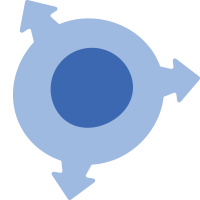
ESC & iPSC News
ESC & iPSC News is an online resource dedicated to the latest research in the fields of embryonic stem cells (ESCs) and induced pluripotent stem cells (iPSCs).
A Novel Protein CYTB-187AA Encoded by the Mitochondrial Gene CYTB Modulates Mammalian Early Development
[Cell Metabolism] Researchers demonstrated that cytochrome b (CYTB) also encoded an unrecognized 187-amino-acid-long protein, CYTB-187AA, using the standard genetic code of cytosolic ribosomes rather than the mitochondrial genetic code.
ISWI Chromatin Remodeling Complexes Recruit NSD2 and H3K36me2 in Pericentromeric Heterochromatin
[Journal of Cell Biology] Investigators revealed the mechanism of heterochromatin targeting of histone H3 lysine36 dimethylation (H3K36me2). Among several H3K36 methyltransferases, NSD2 was responsible for inducing heterochromatic H3K36me2.
Unraveling the Impact of ZZZ3 on the mTOR/Ribosome Pathway in Human Embryonic Stem Cells Homeostasis
[Stem Cell Reports] Scientists investigated the role of zinc finger ZZ-type containing 3 (ZZZ3) in human ESCs homeostasis. They found that knockdown of ZZZ3 negatively impacted ribosome biogenesis, translation, and mTOR signaling, leading to a significant reduction in cell proliferation.
Malat1 Affects Transcription and Splicing through Distinct Pathways in Mouse Embryonic Stem Cells
[NAR Genomics and Bioinformatics] Researchers performed a nuclear knockdown of Malat1 in mESCs, causing the de-regulation of 320 genes and aberrant splicing of 90 transcripts, some of which potentially affecting the translated protein sequence.
Forward Programming Human Pluripotent Stem Cells into Microglia
[Trends in Cell Biology] Investigators provide a comprehensive assessment of published forward programming protocols that are based on forced expression of key lineage transcription factors.
Scientists Are Trying to Get Cows Pregnant with Synthetic Embryos
[MIT Technology Review] The experiment, at the University of Florida, is an attempt to create a large animal starting only from stem cells—no egg, no sperm, and no conception.
The Transcription Factor OCT6 Promotes the Dissolution of the Naïve Pluripotent State by Repressing Nanog and Activating a Formative State Gene Regulatory Network
[Scientific Reports] The authors showed that Oct6 was not expressed in mESCs but was rapidly induced as cells exit the naïve pluripotent state.
H1FOO-DD Promotes Efficiency and Uniformity in Reprogramming to Naive Pluripotency
[Stem Cell Reports] Researchers showed that expressing the maternal-specific linker histone H1FOO fused to a destabilizing domain (H1FOO-DD), together with OCT4, SOX2, KLF4, and LMYC, in human somatic cells improved the quality of reprogramming to both primed and naive pluripotency.
Monocytes Prevent Apoptosis of iPSCs and Promote Differentiation of Kidney Organoids
[Stem Cell Research & Therapy] Differentiation of kidney organoids from human iPSCs was performed. Cell survival and autophagy were analyzed using cell counting kit 8 kit and autophagy detection kit.
ETV4 Is a Mechanical Transducer Linking Cell Crowding Dynamics to Lineage Specification
[Nature Cell Biology] Scientists found that ETS variant transcription factor 4 (ETV4) served as a molecular transducer that linked mechanical microenvironments and gene expression.
Cabinet Approves Two Draft Bills on Regenerative Medicine
[Overseas Community Affairs Council, Republic of China] Executive Yuan approved the Ministry of Health and Welfare's draft bills for a regenerative medicine act and a regenerative pharmaceuticals act.
Heparan Sulfate Chain-Conjugated Laminin-E8 Fragments Advance Paraxial Mesodermal Differentiation Followed by High Myogenic Induction from hiPSCs
[Advanced Science] A system was described for differentiating hiPSCs on new generation laminin fragments, a recombinant form of a laminin E8 fragment conjugated to the heparan sulfate chains attachment domain of perlecan.
Since 2007, ESC & iPSC News has been providing updates on the top publications, reviews, and news in pluripotent stem cell research. Through our website, Twitter, and email newsletters, our editorial team is proud to help keep researchers and medical professionals up-to-date with the latest discoveries, jobs, and event postings in the pluripotent stem cell field.

 Cancer Stem Cell News
Cancer Stem Cell News Cell Therapy News
Cell Therapy News Dermal Cell News
Dermal Cell News Endothelial Cell News
Endothelial Cell News ESC & iPSC News
ESC & iPSC News Extracellular Matrix News
Extracellular Matrix News Hematopoiesis News
Hematopoiesis News Hepatic Cell News
Hepatic Cell News Human Immunology News
Human Immunology News Immune Regulation News
Immune Regulation News
 Intestinal Cell News
Intestinal Cell News Mammary Cell News
Mammary Cell News Mesenchymal Cell News
Mesenchymal Cell News Muscle Cell News
Muscle Cell News Neural Cell News
Neural Cell News Organoid News
Organoid News Pancreatic Cell News
Pancreatic Cell News Prostate Cell News
Prostate Cell News Pulmonary Cell News
Pulmonary Cell News
